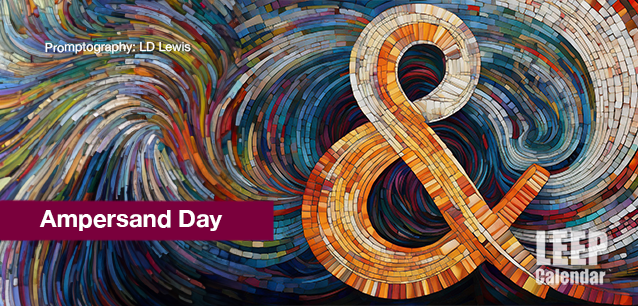 AD
AD
Today is: December 28
Scroll to explore events active on this date.
Additional Events on LEEP
LEEP INK FEATURES

August? Absolutely!
In August, we live through the Dog Days of Summer. It's hot and often humid, and those who can leave for better climates do. Down south, winter is in full force. August is also known as "the ...

In The Heat of July: July 2025 Events
Is it hot enough (or cold enough if you're below the equator) for you yet? There is actually a day for that! Like every month, I pick a diverse collection of events you may or may not know about. This ...

May Blooms: Events in May 2025
Along with October, May is one of the most densely packed months of the year. It's before the summer humidity and the last whole month of the school year. The weather is warming in t...
About National Ampersand Day
Media , United States
Ends: Sep 08, 2024
DESCRIPTION:
TO & OR NOT TO &
NATIONAL AMPERSAND DAY
National Ampersand Day, celebrated annually on September 8, honors one of the most recognizable symbols in the English language: the ampersand (&). This quirky character, often used to represent the word "and," has a rich history that dates back centuries and remains a staple in modern writing and design.
The ampersand originated from the Latin word "et," which means "and." The symbol itself is a ligature, a combination of the letters "e" and "t" written together in a cursive style by Roman scribes. Over time, this combination evolved into the unique shape we now recognize as the ampersand. The earliest known usage of the ampersand dates back to the first century CE when it appeared in Roman script. Its design has changed over the centuries, but the core concept remains unchanged.
The word "ampersand" is derived from a historical phrase used in English classrooms. When students recited the alphabet, they would conclude with "and per se and," meaning "and by itself (is) and." This phrase was gradually slurred together to form the word "ampersand," which entered common usage by the 19th century.
The ampersand is a versatile character in the English language. It is frequently used in company names, logos, and branding to represent partnerships or dual concepts, such as "Johnson & Johnson" or "Ben & Jerry's." It's also popular in artistic and decorative contexts, where its elegant curves add visual appeal to designs. Additionally, it plays a crucial role in academic citations, programming languages, and shorthand, where its function is as important as its style, making it both functional and stylish.
National Ampersand Day was founded in 2015 by Chaz DeSimone, a designer and typography enthusiast. DeSimone was captivated by the ampersand's aesthetic, with its elegant curves and unique shape, and its historical significance, dating back to Roman script. He wanted to celebrate its role in language and design, recognizing its ability to add visual appeal and convey a simple yet powerful connection between words. The day encourages people to appreciate the ampersand's unique form and explore creative ways to use it in their work and everyday writing.
Although not as frequently used as standard alphabetic characters, the ampersand remains a popular and enduring symbol in the English language. Its ability to convey a simple yet powerful connection between words ensures that the ampersand will continue to hold a special place in written and visual communication, providing a reassuring and shared cultural symbol for all of us.
VIDEOS
SUPPORTING DOCUMENTS
Currently, this event does not have supporting documents.
ADDITIONAL IMAGES
Currently, this event does not have supporting images.
Where would you like to go now?
 AD
AD


/footer-logo.svg)
